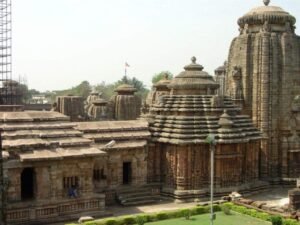[vc_row][vc_column][vc_column_text]
Lingaraj Temple, Bhubaneswar
The lingaraj Temple located in Bhubaneswar, Odissha is of Lord Shiva- one of the ‘tridev’, who is worshipped by Hindus across the world. In addition to the idol form, Lord Shiva is also worshipped in an abstract or iconic manner – ‘called, the ‘linga’, or ‘shivlinga’. A shivling in symbolizes the union of the mind and the soul.
Highlights of Lingaraj Temple:
| Principal deity: | Lord Shiva |
| Location: | Bhubaneswar, Odisha |
Lingraraj temple is one of the oldest temples of Bhubaneswar. The word Lingaraj means ‘king of the lingams’ and refers to the iconic form of Lord Shiva. Shiva was worshipped as Tribhuvaneshwara (or Bhubaneswar), the master of three worlds, namely, heaven, earth, and the netherworld. His consort is called Bhuvaneshvari.
History of Lingaraj Temple:
The history of the temple goes back to the 11th century. As per the belief, the work on the temple was initiated during the 6th century by Lalat Indu Keshari. The work on the Assembly hall (jagamohana), sanctum, and temple tower started during the 11th century. The Hall of offering (bhoga-mandapa) was built later, during the 12th century. The Nata Mandira was built between 1099 and 1104 CE. The temple was finally completed in the last years of the 11th century. The credit of initiating the work on the temple goes to a somvanshi king, Yayati I, and was later renovated by Jajati Keshari, another king of the same dynasty.

Legend Associated with Lingaraj temple:
The Lingaraj temple is situated near the Bindu Sagar Lake. There is a very popular legend associated with this lake.
According to legend, after marriage, Lord Shiva and Parvati went to Kashi (Varanasi). But with the passage of time, the area became crowded, and so Lord Shiva moved to a forest area called ‘Ekamra Kshetra’ (also called ‘Gupt Kashi’, meaning secret Kashi). This forest had many trees, but only one mango tree. So, Lord Shiva sat under this tree to meditate in disguise. This place was not known to anyone, not even to Parvati. So, searching for Lord Shiva, Parvati with reference from Lord Bramha reached this place. But, she could not find him, as he was meditating in disguise. But she noticed several cows there, which we’re going under the huge mango tree and automatically milking a place. She understood that her Lord Shiva is there. So she started living there and started taking care of cows, disguised as a milkmaid.
Two demons named, Kirti and Vasa saw Devi Parvati and proposed to marry them. Maan Parvati got angry and killed both of them by pressing them into the ground with her feet. This place became famous ‘Devi Padahara’. Tired after this, she took rest at a place, which is now called ‘Bhabani Shankar Temple’. When Maan Parvati felt very thirsty, Lord Shiva stuck his trishool (trident) at this place to quench her thirst lord. Immediately a spring of water came out. Siva struck his trident at this place, out of which a spring came out, which took the shape of a large lake, which is today known as Bindu Sagar.
The water of this lake is believed to have healing powers, which can heal and treat many physical and mental problems.
Lingaraj Temple Architecture:
Lingaraj temple was built in the traditional style of the Kalinga dynasty and made up of sandstone and laterite. The temple faces the east direction, where the main entrance is located, with small entrances in the north and south. The temple is built in the ‘deul’ style, which means there are 4 components – ‘vimana’ (sanctum, where the main deity resides), jagmohana (assembly hall), Nata Mandir (dance hall), and bhoga-mandapa (hall of offerings). The dance hall was associated with the rising prominence of the devadasi system that was prevalent at that time.
All these four structures are in axial alignment and have descending heights, with the sanctum being the tallest. According to historian James Fergusson, “Lingaraja Temple is one of the finest examples of purely Hindu temple in India.
The main Lingaraja temple is surrounded by 150 small shrines in its huge courtyard. The man entrance gate of the temple is made in sandalwood. The hall has the exterior of decorative shapes of men and beast and the tower wall has shaped of female figures in different poses.

Significance of the Lingaraj Temple:
The Lingaraj temple is situated near a lake, called the Bindu Sagar Lake. On the western banks of this lake, there is a beautiful garden, called ‘Ekamra van’ (which literally means a forest with one mango tree). This garden is even mentioned in ancient Hindu mythological texts as a forest, which has only one mango tree. As per 13th century Sanskrit literature, ‘Ekamra Puraan’ the original deity was originally placed under this mango tree. This forest was a key element in the abode of Lord Shiva and his divine consort, Goddess Parvati. Even now the garden has several plants which have medicinal properties, and spiritual significance, as they are associated with Hindu gods and goddesses. This is why the city of Bhubaneswar is also called ‘Ekamra Kshetra’.
Lingaraj exemplifies the co-existence of two of the supreme powers of the universe – Vishnu, and Shiva, as a common deity. This temple was built for the Hindus, and even to date, non-Hindus are not allowed in the temple. Once even Indira Gandhi, the ex-Prime Minister was not allowed to enter the temple, because she was married to a non-Hindu. Every day, about 5 to 6 thousand people visit the temples. On special days, the temple receives lakhs of visitors.
It is believed that when the Lingaraj temple was about to be completed, there was a huge insurgence of Jagannath culture in Odisha. That is why, the presiding deity at Lingaraj temple is known as ‘Hari-Hara’, where ‘Hari’ means Lord Vishnu and Hara refers to Lord Shiva, which indicates the co-existence of Lord Shiva and Lord Vishnu.
The lingam in the sanctum of the temple is a natural unshaped stone that rests on a Shakti, and is believed to be one among the 64 ‘Swayambhoo Lingam’ (self-originated) which emerged during the ‘Dwaapar yug” and “Kali yug’. This rises to a height of 8 inches above the floor level and is about 8 feet in diameter.
Main Festivals:
The biggest celebrated festival in the name of Lord Shiva is Maha Shivraatri, which is celebrated on the night between the ‘troyadashi’ (13th day) and ‘chatrurdashi’ (14th day) in the Phalgun month of the Hindu calendar. To celebrate this occasion, a Maha-Pooja is conducted which is held at midnight. The pooja is conducted with a lot of devotion and religious fervour. Lakhs of people throng the temple to witness the pooja and get blessings and prasad of Lord Shiva.
The devotees fast all day long and pray to Lord Shiva. Bel leaves, dhatura are the main offerings especially for this day and devotees break their fast at midnight after Maha-Deepa.
Best Time to Visit Lingaraj Temple:
Lingaraja temple is open throughout the week. The timings are from 6:00 am to 9:00 pm but the doors get closed between 12:00 pm to 3:30 pm. This time usually changes according to the weather condition.
The best time to visit Bhubaneswar is from October to March when the temperature is low and the weather is very pleasant and cool. December and January months are usually cold, while April and May are very hot and humid. These months are not ideal for a visit to the city.
How to reach Lingaraj Temple?
- By Airway: The nearest airport is Biju Patnaik Airport, which is just 3 km away from Bhubaneswar. There are regular flights for Bhubaneswar from all major cities like New Delhi, Chennai, Mumbai, Kolkata, Hyderabad, Bangalore, and Visakhapatnam.
- By Railway: The railway station is Bhubaneswar, at a distance of just 5 km away from the main city. Being the headquarters of the East coast of the railway, there are regular trains from all major cities like Kolkata, Mumbai, Delhi, Chennai, Hyderabad, Bangalore, etc. Once you reach Bhubaneswar, you can take a bus or hire a taxi to reach the temple.
- By Roadway: In an advanced city like Bhubaneswar because of the National Highway 5, it is easy to get both public or private buses to travel which are interconnected to other nearby cities. The nearby cities are Cuttack (33 km), Bramhapur (150 km), Raurkela (240 km), and Ranchi (350 km)
Pooja Vidhis Performed at Lingaraja Temple:
There are three routine aartis (waving of lights) which have a decided timing, morning Lingaraja’s temple door open at 6:00 am and after the bhog and mahasnana first aarti of the day takes place and after that in noon door are closed from 1:00 pm to 3:30 pm. At 7:00 pm another aarti is performed called Sandhya aarti and after the last meal of the day the last aarti is performed before the deity. The bilva leaves and the tulsi leaves are used in daily worship. Every day there is great decoration with flowers, sandal paste and cloths serval times in a day. There are several offerings is performed throughout the day.
Quick Facts About Lingaraj Temple:
Lingaraj Temple is the second most popular destination of Odisha, the first being Jagannath Temple at Puri. This temple signifies the co-existence of Lord Vishnu and Lord Shiva in the form of ‘hari-hara’. The temple is located near Bindu Sagar Lake, which is said to have spiritual significance, as the lake was created by Lord Shiva for Goddess Parvati. The water of his lake is said to have healing properties. Every year, the idol of Lingaraj is brought to this lake for a ‘snaan’ (bath) following a ritual.
The place is open for Hindus only. Though there is no dress code, people are expected to be dressed modestly. Women are expected to wear the Indian dress code only. Dresses like short skirts and shorts should strictly be avoided.
FAQs:
Q.1: What is the meaning of Lingaraj?
Ans: The word Lingaraj means “The King of Lingam”
Q.2: What is the meaning of ‘Ekamravan’?
Ans: ‘Ekamravan’ means a forest having one mango tree.
Q.3: Which place is known as ‘Gupt Kashi’?
Ans: Amravan near Lingaraj Temple
Q.4: Are non-Hindus allowed entry in the Lingaraj Temple?
Ans: No, non-Hindus are not allowed entry inside the Lingaraj Temple
Q.5: Which political leader was denied entry into the Lingaraj Temple because of religion?
Ans: Indira Gandhi, the ex-Prime Minister of India
Reference:
https://en.wikipedia.org/wiki/Bindusagar_Lake
https://whc.unesco.org/en/tentativelists/5916/
https://en.wikipedia.org/wiki/Chaturdash
https://en.wikipedia.org/wiki/Dvapara_Yuga[/vc_column_text][/vc_column][/vc_row][vc_row][vc_column][vc_column_text]
Get Direction On Google Map
[/vc_column_text][vc_raw_html]JTNDaWZyYW1lJTIwc3JjJTNEJTIyaHR0cHMlM0ElMkYlMkZ3d3cuZ29vZ2xlLmNvbSUyRm1hcHMlMkZlbWJlZCUzRnBiJTNEJTIxMW0xNCUyMTFtOCUyMTFtMyUyMTFkMTQ5NzMuOTk2MjMyNzA2MjQlMjEyZDg1LjgzNDMwNzQlMjEzZDIwLjIzODEyNzIlMjEzbTIlMjExaTEwMjQlMjEyaTc2OCUyMTRmMTMuMSUyMTNtMyUyMTFtMiUyMTFzMHgwJTI1M0EweDIxMjg0NWY4OTQ1NmEyY2QlMjEyc0xpbmdhcmFqYSUyNTIwVGVtcGxlJTIxNWUwJTIxM20yJTIxMXNlbiUyMTJzaW4lMjE0djE2MjUwNDkxNzIwNTglMjE1bTIlMjExc2VuJTIxMnNpbiUyMiUyMHdpZHRoJTNEJTIyMTAwJTI1JTIyJTIwaGVpZ2h0JTNEJTIyNDUwJTIyJTIwc3R5bGUlM0QlMjJib3JkZXIlM0EwJTNCJTIyJTIwYWxsb3dmdWxsc2NyZWVuJTNEJTIyJTIyJTIwbG9hZGluZyUzRCUyMmxhenklMjIlM0UlM0MlMkZpZnJhbWUlM0U=[/vc_raw_html][/vc_column][/vc_row]








